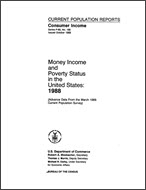Money Income and Poverty Status in the United States: 1988 (Advance Data From the March 1989 Current Population Survey)
Money Income and Poverty Status in the United States: 1988 (Advance Data From the March 1989 Current Population Survey)
Note
Income and poverty estimates in this report are the first to reflect a new processing system that has been incorporated into the March income supplement to the Current Population Survey. A description of the new procedures and their effect on income and poverty estimates can be found in the section discussing the revisions. The comparisons in this report between 1987 and 1988 data are based on the new processing procedures for both years. The tables in this report have also been redesigned. Table contents have been revised and expanded to reflect the changing needs of users. In addition, though official estimates of income and poverty in this report are based on the CPI-U, this is the first Census Bureau report to include information on the use of the CPI-U-X1 as a price index. Use of the CPI-U-X1 as a price deflator provides a different picture of economic progress during the past 15 years. However, trends since 1982 are similar since both indexes have been calculated using the same methodology since that year. See the report section on historical trends for a further discussion of price indexes and their effect on income and poverty estimates.
Introduction
This report presents data on the income and poverty status of households, families, and persons in the United States for the calendar year 1988. These data were compiled from information collected in the March 1989 Current Population Survey (CPS) conducted by the Bureau of the Census. The survey consisted of approximately 58,000 households nationwide and was designed mainly to produce reliable national estimates, though some data by region and metropolitan residence were also compiled and appear in this report.
The official income and poverty estimates in this report are based solely on money income before taxes and do not include the value of noncash benefits such as food stamps, Medicare, Medicaid, public housing and employer-provided fringe benefits. However, appendix D contains estimates of the distribution of income and prevalence of poverty before and after the inclusion of the value of these types of benefits, while holding the official poverty thresholds constant. These estimates replace those that had previously been included in the Census Bureau's Technical Paper series.
This report differs from previous advance income reports in that year-to-year changes in both household and family income are analyzed. Previous advance reports analyzed changes in family income only. Families are groups of two or more persons related by birth, marriage, or adoption who reside together. Households are more loosely defined; they consist of any person or group of persons that occupy a housing unit. A person living alone (or a group of unrelated individuals sharing a housing unit) is included as a household but not as a family. Thus, the main difference between household and family income measures is that household income reflects virtually the entire CPS survey universe, while family income is restricted to the income of persons living in family units.
The report begins with a section on household income, with year-to-year comparisons by region, type of residence, and type of household. This is followed by a section on changes in family income by race, Hispanic origin, age of householder and family composition. Sections on earnings of year-round, full-time workers and per capita income follow the family income section.
Changes in poverty rates and the number of poor are shown for persons by race and Hispanic origin and geographic distribution. Changes in the poverty status of families are displayed by race, Hispanic origin, work experience, and education of householder. There is also a section on the amount of money it would take to raise the incomes of all poor families to their respective poverty thresholds (income deficit).
The report concludes with sections on the trends in money income and poverty status, and a discussion of the effects of the new CPS processing system on the estimates. Also included is an appendix on the effect of including noncash benefits.
A Note on Language
Census statistics date back to 1790 and reflect the growth and change of the United States. Past census reports contain some terms that today’s readers may consider obsolete and inappropriate. As part of our goal to be open and transparent with the public, we are improving access to all Census Bureau original publications and statistics, which serve as a guide to the nation's history.
Others in Series
Publication
Publication
Publication






